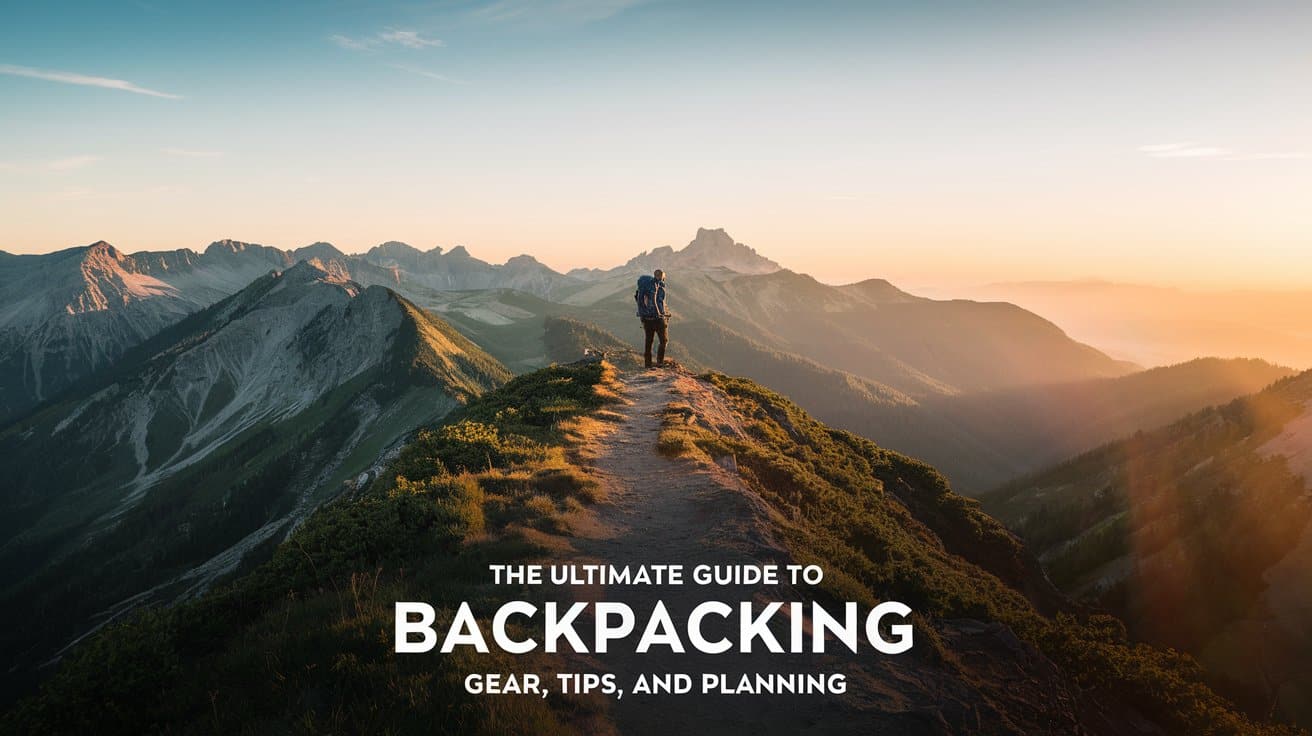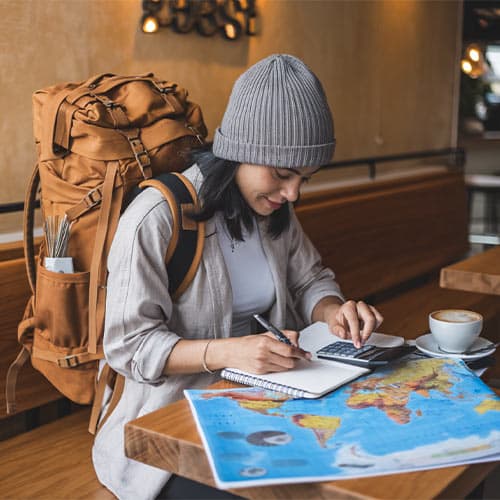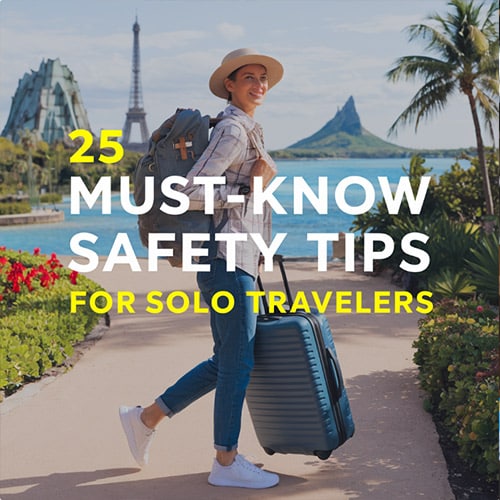The Ultimate Guide to Backpacking: Gear, Tips, and Planning [2025]
Hi there, I’m Emma Collins, a solo traveler who’s always chasing the thrill of the unknown. If you’ve ever dreamed of leaving your comfort zone, then backpacking might be for you. It means trading the chaos of daily life for nature’s serenity. It means carrying your world on your back.
For me, backpacking started as a simple idea way to escape, explore, and connect. But it’s become so much more. It’s an adventure, a teacher, and sometimes even a test of will. Whether you’re a seasoned hiker or a total beginner, this guide will help you gear up, plan smart, and make your journey unforgettable.
Ready to discover the freedom and magic of backpacking? Let’s dive in.
Why Backpacking is the Ultimate Adventure
Backpacking isn’t just a way to travel; it’s an experience that can redefine how you see the world and yourself. Carrying all you need on your back is raw and real. It means stepping into the unknown and embracing the unexpected.
Benefits of Backpacking
Backpacking offers more than just scenic views it’s transformative.
- Connection with Nature: Imagine waking up to the sound of birds chirping or watching a sunrise paint the mountains golden. Backpacking immerses you in nature like nothing else.
- Sense of Accomplishment: Reaching a summit or completing a challenging trail brings a deep sense of pride and fulfillment. You’ll learn just how capable you are.
- Mental Recharge: It’s a chance to disconnect from the digital world and reconnect with yourself. The quiet trails can be the perfect escape from life’s noise.
- Budget-Friendly Travel: Forget expensive hotels or tourist traps. Backpacking lets you explore incredible places without breaking the bank.
What Makes Backpacking Unique
Backpacking stands apart because it’s more than just a trip it’s a journey of growth and discovery.
- Freedom to Explore: You choose your path, pace, and destination. There’s no rigid itinerary holding you back.
- Minimalist Lifestyle: Living with just the essentials teaches you to value simplicity and focus on what truly matters.
- Unpredictable Adventures: No two trips are ever the same. A chance encounter, a stunning view, or a sudden change in weather can turn a day into a story you’ll tell for years.
In the end, backpacking isn’t just about where you go it’s about who you become along the way.
Choosing Your Perfect Backpacking Trail
Picking the right trail is where your adventure truly begins. The trail you choose sets the tone for your experience, whether it’s a peaceful walk through the woods or a challenging trek up a mountain.
Understanding Trail Types
Trails come in all shapes and sizes, and knowing what’s ahead can make or break your trip.
- Loop Trails: These start and end at the same spot, making logistics simple. Perfect for beginners who want a straightforward experience.
- Out-and-Back Trails: You’ll hike to a specific point and then retrace your steps. These are great for exploring at your own pace.
- Thru-Hikes: Epic multi-day journeys that stretch across regions, like the Appalachian Trail. They’re ideal for seasoned adventurers looking for a life-changing challenge.
Researching Trail Details
Before lacing up your boots, do your homework. Each trail has its own personality, and it’s important to know what you’re getting into.
- Length and Difficulty: Check the trail’s distance and elevation gain to match it with your fitness level.
- Season and Weather: Trails change with the seasons. Research the best time to visit and prepare for weather surprises.
- Permits and Regulations: Some trails require permits or have specific rules to follow, like campsite restrictions.
- Wildlife Considerations: Be aware of local wildlife and carry the necessary precautions, especially in areas with bears or snakes.
Best Backpacking Destinations for 2025
Dreaming of your next trail?
- Pacific Northwest, USA: Think lush forests, rugged coastlines, and breathtaking waterfalls. The Olympic National Park is a standout.
- Torres del Paine, Chile: This trail offers jaw-dropping views of jagged peaks, glacial lakes, and sprawling valleys.
- The Dolomites, Italy: A mix of culture and natural beauty with dramatic cliffs and charming mountain huts.
- The Great Ocean Walk, Australia: Stunning coastal views, secluded beaches, and eucalyptus forests make this trail unforgettable.
Essential Backpacking Gear Checklist
The right gear can mean the difference between a dream trip and a nightmare. Let’s make sure you’re packed and ready for anything.
Must-Have Gear
These essentials will keep you prepared for the trail ahead:
- Backpack: Choose one that fits well and holds all your gear comfortably. Look for a capacity of 50–70 liters for multi-day trips.
- Tent or Shelter: Lightweight and weather-resistant is the way to go. Make sure it suits the conditions of your trail.
- Sleeping Bag and Pad: Invest in a sleeping bag rated for the expected temperatures and a pad for extra comfort.
- Navigation Tools: A map, compass, or GPS device is crucial for staying on track.
Clothing Essentials
Backpacking is all about layering smart. Pack clothes that are functional, lightweight, and versatile:
- Base Layer: Moisture-wicking tops and bottoms to keep sweat at bay.
- Mid Layer: Fleece or down jackets for warmth.
- Outer Layer: A waterproof jacket and pants for unexpected rain.
- Extras: A hat, gloves, and quick-drying socks are lifesavers on the trail.
Safety and Emergency Gear
Safety first!
- First Aid Kit: Include bandages, pain relievers, and antiseptics. Customize it based on the trail’s remoteness.
- Multi-Tool or Knife: For cutting, repairing, or opening gear.
- Fire Starters: Waterproof matches or a reliable lighter can help in emergencies.
- Emergency Blanket: Compact and lightweight, it’s a must for staying warm in case of an emergency.
By choosing the right trail and packing smart, you’re setting yourself up for an unforgettable adventure. Next, let’s talk about how to prepare and plan like a pro!
Planning and Preparation for a Seamless Trip
When it comes to backpacking, the key to a smooth trip lies in the preparation. Getting ready doesn’t just mean packing your gear; it’s about preparing your body and your mind for the adventure ahead.
Getting in Shape for Backpacking
You don’t need to be an athlete, but getting in shape is a smart way to make your hike more enjoyable. After all, the trail can throw some tough challenges your way, and you’ll need strength, stamina, and a good sense of balance to keep going.
- Cardio Training: Hiking is all about endurance, so get your heart pumping with activities like running, cycling, or brisk walking. Aim for 30 minutes of cardio, 3–4 times a week.
- Strength Training: Focus on your legs and core. Squats, lunges, and planks are all great exercises to build strength for those uphill climbs.
- Practice Hikes: Don’t wait until the big day. Take shorter hikes with a loaded backpack to simulate the real deal and get your body used to the weight.
Packing Your Backpack the Right Way
Packing might sound simple, but there’s an art to it. A well-packed backpack can save your back and make it easier to access what you need while on the trail.
- Pack Light: Only bring what’s necessary. Every extra pound adds up quickly, so leave behind the non-essentials.
- Heaviest Items First: Place your sleeping bag and pad at the bottom, with the heaviest items like your stove and food next.
- Keep Essentials Accessible: Things like your map, snacks, and water should be easy to grab without taking everything out.
- Use Compression Sacks: These help save space and keep your gear organized.
Pre-Trip Planning Steps
It’s easy to get caught up in the excitement, but a little planning goes a long way.
- Check the Weather: The forecast can change fast, especially in the mountains. Keep an eye on conditions and adjust your plans if needed.
- Confirm Your Permits: Many trails require permits, especially in protected areas. Double-check that you’ve got the right permits, and be aware of any specific rules.
- Let Someone Know: Share your itinerary with a friend or family member. It’s always good to have someone know your plans in case something goes wrong.
Mastering Essential Backpacking Skills
To make sure your trip goes smoothly, you’ll need to master a few key skills. These basics will help you feel confident on the trail, no matter what happens.
Navigation Basics
Getting lost on a trail is every backpacker’s nightmare, but with the right navigation skills, you can avoid that pitfall.
- Map and Compass: Learn how to read a map and use a compass to orient yourself. This skill is priceless when the trail markers disappear or the weather’s foggy.
- Using a GPS: While technology is great, don’t rely on it entirely. Always bring a backup like a map and compass.
- Landmarking: Familiarize yourself with the terrain. Noticing key features like a distinct mountain or a river bend can help you stay on track.
Leave No Trace Principles
Backpacking isn’t just about your adventure; it’s about respecting the wilderness you’re exploring. Following Leave No Trace (LNT) principles is a way to minimize your impact on the environment and keep it pristine for future travelers.
- Pack It In, Pack It Out: Anything you bring, you need to take back with you, including trash and food scraps.
- Stay on the Trail: Stick to marked paths to avoid disturbing fragile ecosystems.
- Minimize Campfire Impact: Campfires can leave lasting scars on the landscape. Use a camp stove instead when possible.
- Respect Wildlife: Keep your distance, and never feed animals.
Setting Up a Campsite
After a long day of hiking, finding a good spot to camp is key to a restful night’s sleep. Here’s how to make sure you’re setting up camp safely and efficiently.
- Flat, Dry Ground: Look for a level spot that isn’t too close to water sources (to avoid flooding or animal activity).
- Shelter Placement: Set your tent up away from wind, if possible. Avoid pitching your tent under dead trees or near rocks that could fall in a storm.
- Campfire Safety: If you must have a fire, make sure it’s in a designated fire ring. Never leave it unattended, and fully extinguish it before bed.
Mastering these skills will make your trip safer and more enjoyable. But don’t forget: a successful backpacking adventure is about more than just being prepared. It’s about soaking in the beauty, the challenge, and the peace that come with being in nature. Ready to learn how to fuel your journey? Let’s dive into meal planning!
Backpacking Food and Meal Planning
When you’re out on the trail, food becomes more than just a necessity it’s fuel for your body. After a long day of hiking, nothing feels as satisfying as enjoying a warm meal, especially when you’ve put in the work. But planning meals for backpacking trips can be tricky. You need to strike the right balance between convenience, nutrition, and weight.
High-Energy Foods for the Trail
When you’re out on the trail, you’ll need food that gives you long-lasting energy without weighing you down. Focus on high-energy foods that are easy to pack and won’t spoil easily.
- Nuts and Seeds: Packed with healthy fats and protein, these are perfect for quick energy. Think almonds, cashews, or sunflower seeds.
- Dried Fruits: Lightweight and loaded with natural sugars, dried fruits like raisins, apricots, or apples provide a quick burst of energy.
- Granola Bars & Energy Bars: These are a backpacker’s best friend. Choose options with a good mix of carbs, protein, and healthy fats.
- Dehydrated Meals: These are easy to prepare just add hot water! Look for options that offer a balance of carbs, protein, and veggies.
- Jerky: Beef or turkey jerky provides protein and is easy to pack. Look for low-sodium versions for a healthier snack.
Make sure you’re eating balanced meals throughout the day to keep your energy levels steady. And always have a variety of snacks on hand to avoid burnout from eating the same thing all day.
Meal Preparation Tips
Packing and preparing meals for backpacking doesn’t have to be complicated.
- Prep Ahead of Time: At home, pre-portion your meals into individual bags or containers. It’s easier than carrying bulky packages, and you can customize your portions.
- Stick to Lightweight Options: Avoid anything too heavy, like cans or glass jars. Choose freeze-dried or dehydrated options when possible.
- Don’t Forget a Stove & Fuel: A compact camp stove and a small fuel canister are essential for cooking meals on the go. Test your stove before the trip to ensure it works properly.
- Bring Simple Cooking Tools: A lightweight pot, a spork, and a small knife should be all you need. Don’t overcomplicate things.
Common Backpacking Challenges and How to Overcome Them
Backpacking can be a challenge after all, you’re out in the wilderness where things can go wrong. But knowing how to handle common problems will help you stay calm and keep moving forward.
Navigating Weather Challenges
Weather can change in the blink of an eye, especially in the mountains. One minute, you’re basking in the sun, and the next, a storm could roll in. Being prepared is the best way to handle weather challenges.
- Check the Forecast Regularly: Before heading out, make sure you check the weather forecast. If there’s a chance of rain or snow, pack appropriate gear like a waterproof jacket or poncho.
- Prepare for Temperature Fluctuations: The weather can vary wildly between day and night. Pack layers to help you stay comfortable. Think base layers, insulating layers, and a waterproof outer layer.
- Shelter from Storms: If you find yourself in a storm, seek shelter in a sturdy tent or under a rock overhang. Avoid camping in low areas that might flood.
Avoiding and Handling Injuries
No one wants to get hurt on the trail, but accidents can happen. From blisters to sprains, it’s important to know how to prevent injuries and treat them if they occur.
- Prevention is Key: Break in your shoes before hitting the trail, and wear proper socks to prevent blisters. Stay hydrated, and don’t overexert yourself listen to your body.
- First Aid Kit: Always carry a basic first aid kit with bandages, antiseptic wipes, blister treatment, and pain relievers.
- Treat Injuries Quickly: If you do get injured, address the issue immediately. If you twist your ankle, rest, ice, compress, and elevate it (the R.I.C.E. method). For blisters, clean them and apply a blister bandage.
Overcoming Mental Hurdles
Backpacking isn’t just physically demanding it can be mentally tough, too. Long days, challenging terrain, and isolation can all test your resolve. But with the right mindset, you can power through.
- Stay Positive: Keep a positive attitude, even when things aren’t going your way. Break your hike down into smaller, manageable goals. Celebrate the small wins along the way.
- Take Breaks: Don’t be afraid to stop and take a breather. Sometimes, a few minutes of rest can give you the energy you need to push forward.
- Stay Connected to Your Why: Whether it’s the adventure, the solitude, or the beauty of nature, remind yourself why you’re out there. Let your motivation carry you when you feel drained.
Backpacking has its challenges. But, each is a chance to grow stronger physically, mentally, and emotionally. With the right preparation and mindset, you can tackle anything the trail throws your way! Ready for some expert tips to elevate your backpacking game? Keep reading!
Expert Tips for Backpacking Like a Pro
Backpacking is an adventure that gets better with experience. Every journey teaches you something new, but there are some pro tips that can make your trips smoother and more enjoyable from the get-go. Whether you’re a first-timer or a seasoned adventurer, these tricks will help you step up your backpacking game.
Time-Saving Hacks
Time is precious when you’re out on the trail. Between hiking, eating, and setting up camp, every minute counts.
- Prep Meals in Advance: As mentioned earlier, prepping meals at home and packing them into individual bags can save you a lot of time on the trail. When you’re hungry after a long day of hiking, you won’t want to waste time cooking from scratch. Just add water, heat, and eat.
- Lay Out Your Gear the Night Before: Setting up camp can take a while, especially if you’re tired. To make things easier, unpack your gear and set up your campsite in advance. This way, when you arrive, everything is ready, and you can settle in faster.
- Use a Headlamp: When you’re trying to get things done in the dark, a headlamp is your best friend. Unlike a flashlight, a headlamp frees up your hands, so you can cook, set up, or organize your gear while still seeing what you’re doing.
- Pack Smart: Keep the most essential items (like snacks, water, or your first-aid kit) easily accessible. If you can grab something without digging through your whole backpack, it’ll save time and frustration.
Lessons from Experienced Backpackers
There’s a lot to be learned from those who have spent years exploring the great outdoors. Experienced adventurers have much to share. You can find it by chatting with fellow backpackers at a campsite or by reading blogs and books. Here are a few lessons I’ve picked up from seasoned backpackers:
- Know Your Limits: One of the most important things you can do is to recognize your own limits. Experienced hikers know how to listen to their bodies and don’t push themselves too hard. If you’re feeling exhausted or dizzy, don’t hesitate to take a break or slow down. Your safety and well-being should always come first.
- Stay Flexible: Plans can change in an instant. Whether it’s because of weather, trail conditions, or unexpected delays, experienced backpackers understand the importance of staying flexible. Sometimes, detours or changes in plans lead to the best experiences, so don’t sweat the small stuff.
- Invest in Quality Gear: It might be tempting to go for the cheapest options when you’re on a budget, but experienced backpackers know that quality gear is worth the investment. Proper footwear, a good sleeping bag, and a reliable backpack can make all the difference in how comfortable and safe you are on the trail.
- Build a Community: Backpacking is seen as a solo activity. But, experienced hikers know it’s valuable to connect with others. Whether it’s online groups or meeting fellow travelers on the trail, a strong backpacking community can offer support, advice, and camaraderie.
With these expert tips and lessons in your back pocket, you’re well on your way to becoming a seasoned backpacker in no time! Ready to start planning your next adventure? Let’s dive into the final thoughts!
Final Thoughts
Backpacking is a rewarding adventure that challenges both your body and mind. From choosing the right trail to packing essential gear, proper preparation makes all the difference.
By now, you’ve learned how to plan, what gear to bring, and how to handle common challenges. The key to success is being prepared, staying flexible, and embracing the journey.
So, whether you’re new to backpacking or an experienced traveler, take these tips with you, and enjoy every step of your adventure. Safe travels!





